How to Breed Dart Frogs (Specifically D. auratus)
4 posters
OCHS Member Forum :: Amphibians :: Frogs
Page 1 of 1
 How to Breed Dart Frogs (Specifically D. auratus)
How to Breed Dart Frogs (Specifically D. auratus)
As most of you know, I have been in frogs up to my eyeballs for about 5 months now. With over 50 froglets produced and about a 90% success rate for producing healthy froglets, I must have done something right, so I thought I would write down what I did for anyone who might be considering breeding these cool little critters.
This guide is not about adult dart frog husbandry, but I will go ahead and say a few things about that because you obviously have to have at least 1 healthy, happy pair of adults before you can get eggs.
I keep my quartet of adults in a 20 gallon long tank with hydroton and gravel on the bottom and sphagnum moss as the top substrate. Live plants are absolutely necessary for dart frog tanks. There are many that will work, but I like pothos because even I can't kill the stuff. The general rule is 1 frog for every 5 gallons of tank for this species, but bigger is always better and I wouldn't use anything smaller than a 10 gallon for a single frog or a pair, personally. For every frog in the tank, I have 1 coconut hide. Under each coconut hide is a cut-off deli cup so that the coconut hide sits inside the cup or around it. These deli cups are important for the breeding process. Feed the frogs every day or every 2 days on fruit flies that are dusted with RepCal and Herptivite. When your frogs are of breeding age, you should eventually see something like this in one of the deli cups:
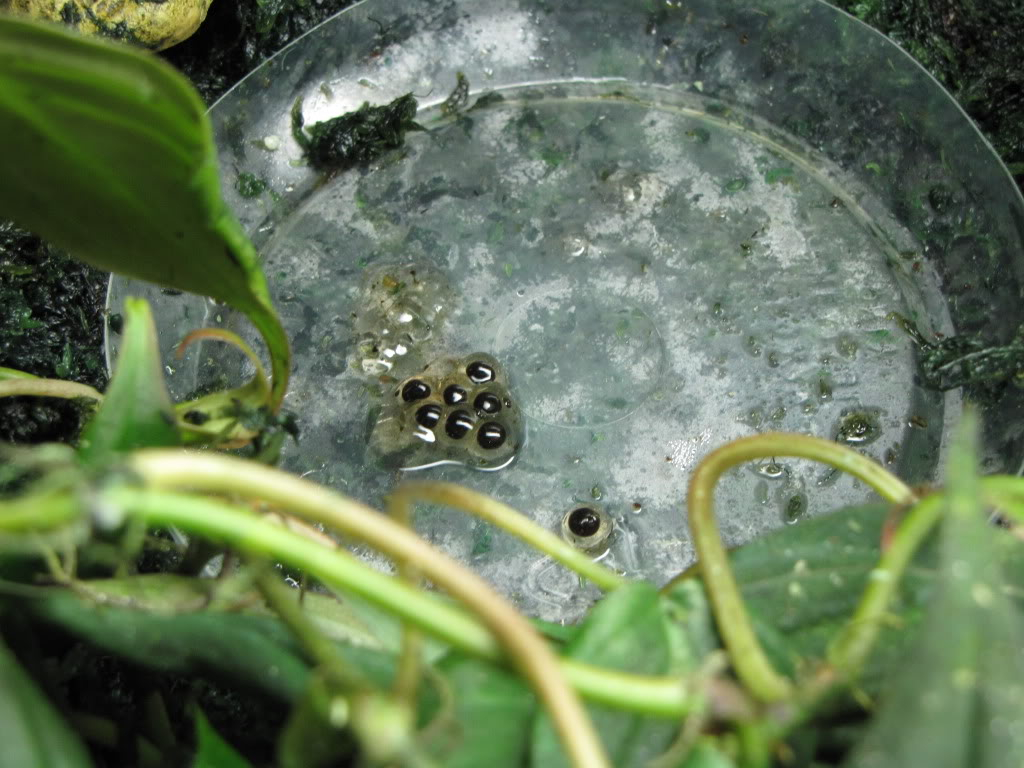
1. When you have found eggs, take out the whole deli cup and replace it with a fresh one. Clean around the eggs and get rid of any debris that is in the cup with them. Be careful not to touch the gel around the eggs. If the eggs are dark and have no white "clouds" in them, they are good. If you have bad eggs that are cloudy white, they need to be removed with a q-tip so they don't cause others to go bad. Be careful not to disturb the other eggs much as you remove the bad ones.
2. When you have a mostly clean cup of eggs, get a tupperware, gladware, etc. container that is big enough for the cup of eggs to fit in. Fill the gladware container with an inch or 2 of water and float the deli cup inside the gladware container. This is your "incubator". Put just enough water in the actual deli cup so that the edge of the water touches the gel. Put the lid on loosely and store somewhere as close to 75 degrees as possible. You're done for a few days.
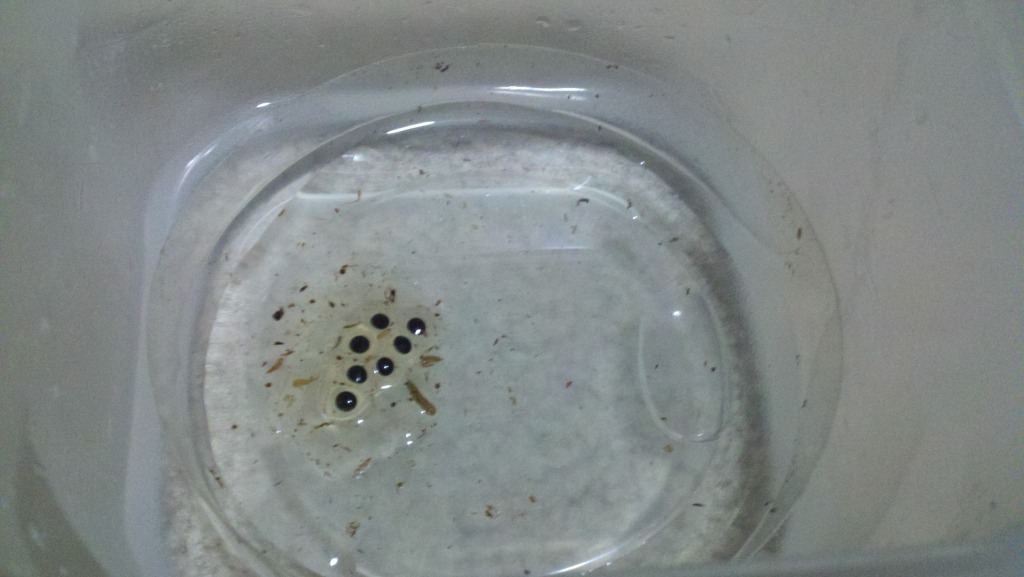
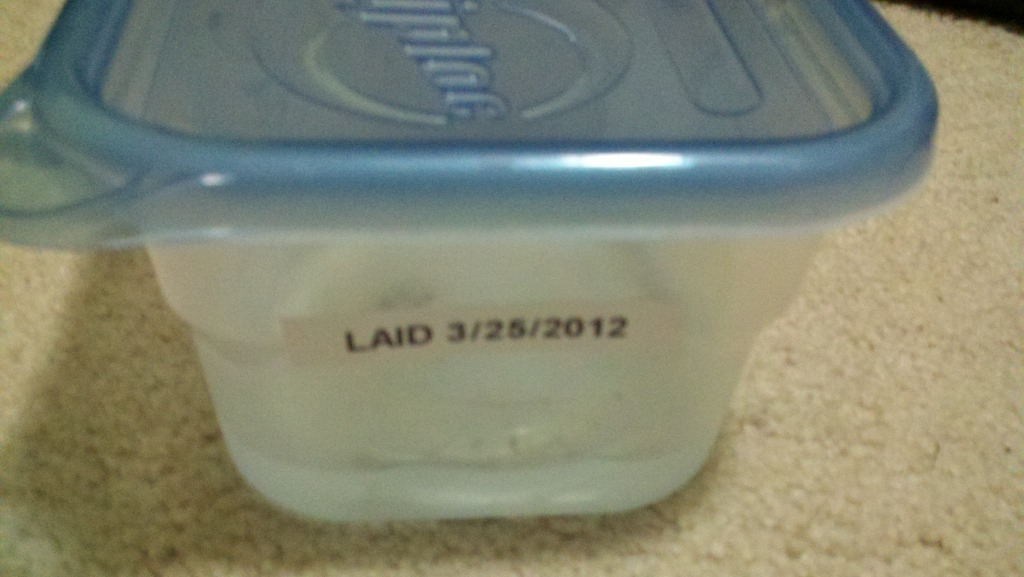
3. In a few days, you will see something like this, if the eggs are good:
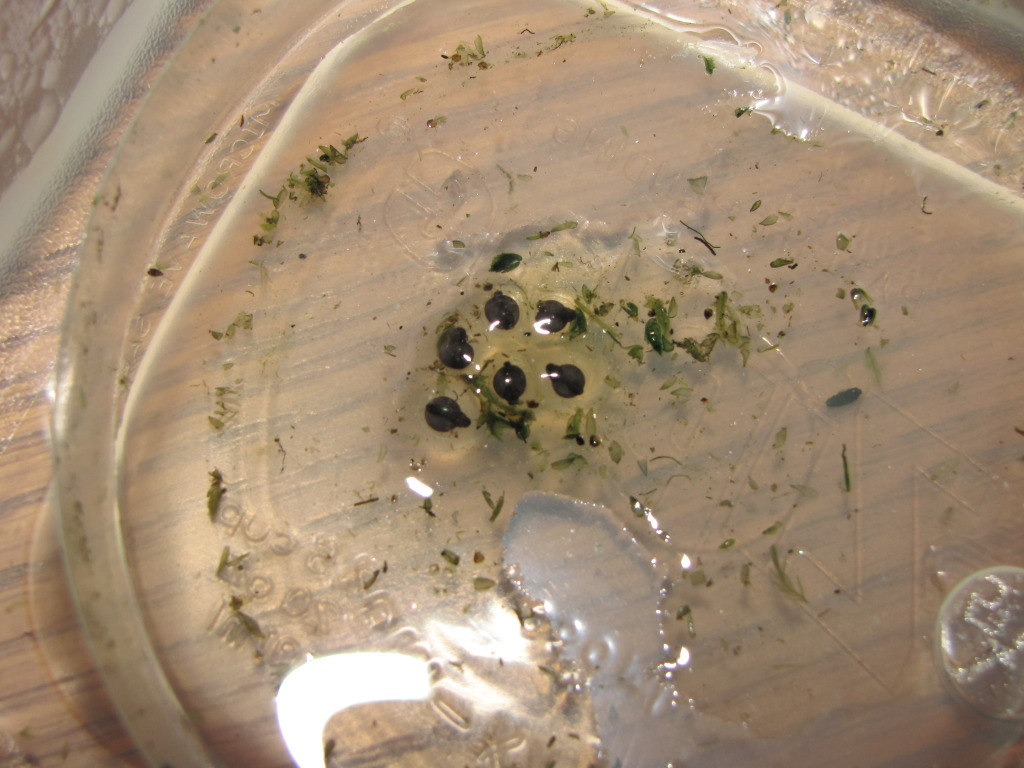
Then another few days:
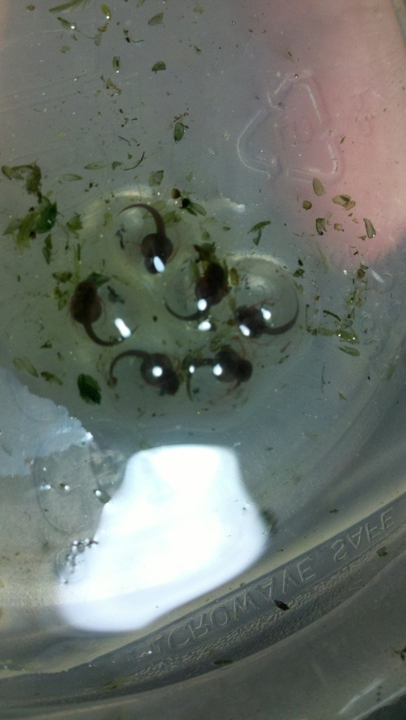
And after about 2 weeks, when the tadpoles start straightening their tails, add more water to help them out of the eggs:
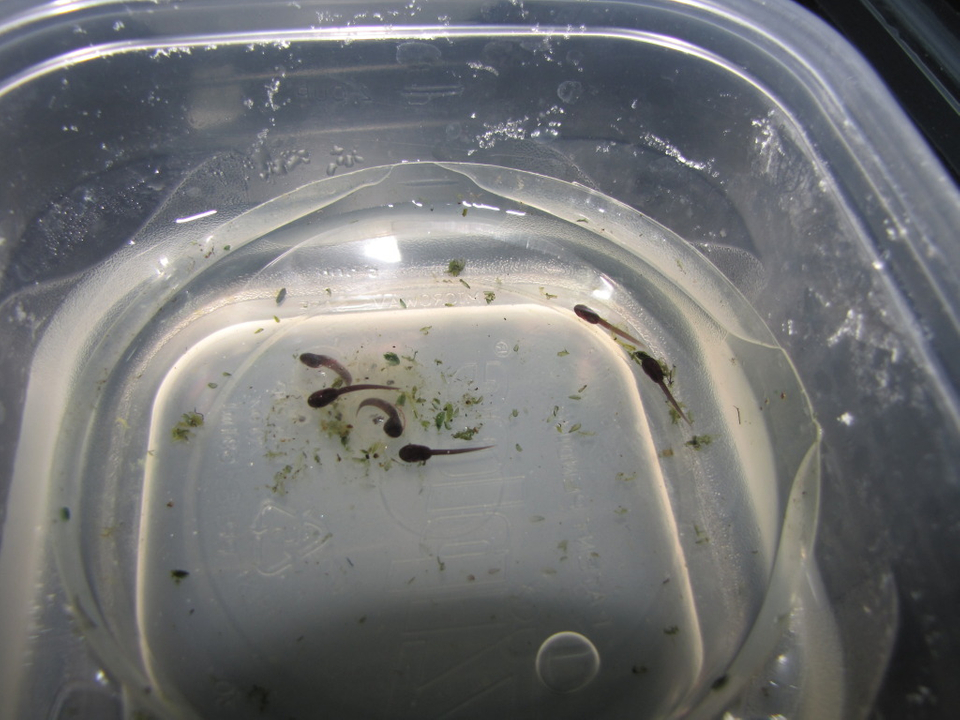
4. When the tadpoles have hatched, you need to take them, one at a time, and put them in separate containers. I use 1 and 1/2 cup gladware or ziploc containers with lids. To remove the single tadpoles, I use an Asian soup spoon, but you can also use a turkey baster to suck up the tadpoles and put them in their new containers. Whichever method you use, be as gentle as possible. Put the lid on very loosely so that a little air can still get in, but flies can't.
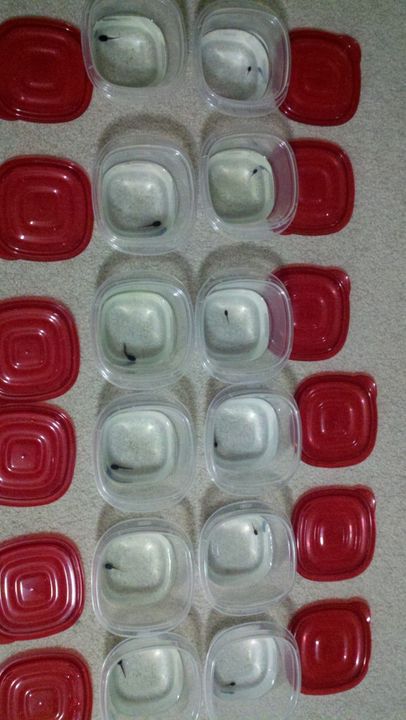


5. When you have put the tadpoles into their new temporary homes, put a very small amount of food in with them. The best food I've found is the algae powder that Patrick Nabors sells at www.saurian.net. I also use BHB Frog/Salamander/Newt pellets every other feeding for extra protein. Feed every other day.
6. Every other day, before feeding, I use the turkey baster to suck out the poop and uneaten food from the last feeding, then refill the water. Only use spring water for amphibians. Never use tap water!
7. After a couple of weeks of feeding and cleaning, you should see back legs forming:

8. Soon after the back legs are fully formed, little bumps will start to form where the front legs will go.
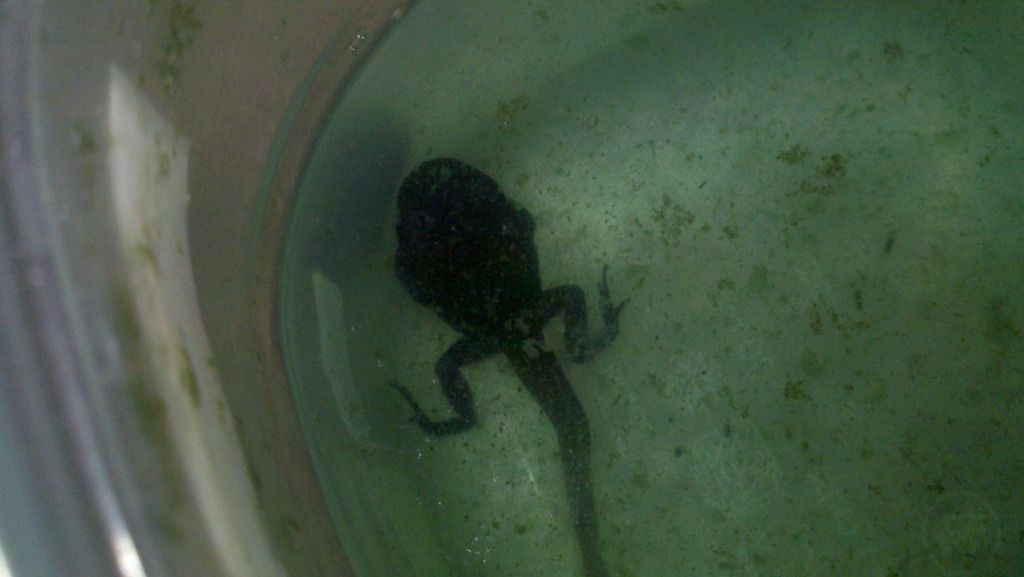
9. When the front legs come in, it is time to move the froglet to another new home and stop feeding it for a while. I use long, ziploc or Gladware containers. Put a clump of sphagnum moss in one side of the container and fill it with enough water to soak the moss and still have about an inch of standing water. Suck most of the water out of the container the froglet is currently in, and gently poor the froglet into the new habitat.
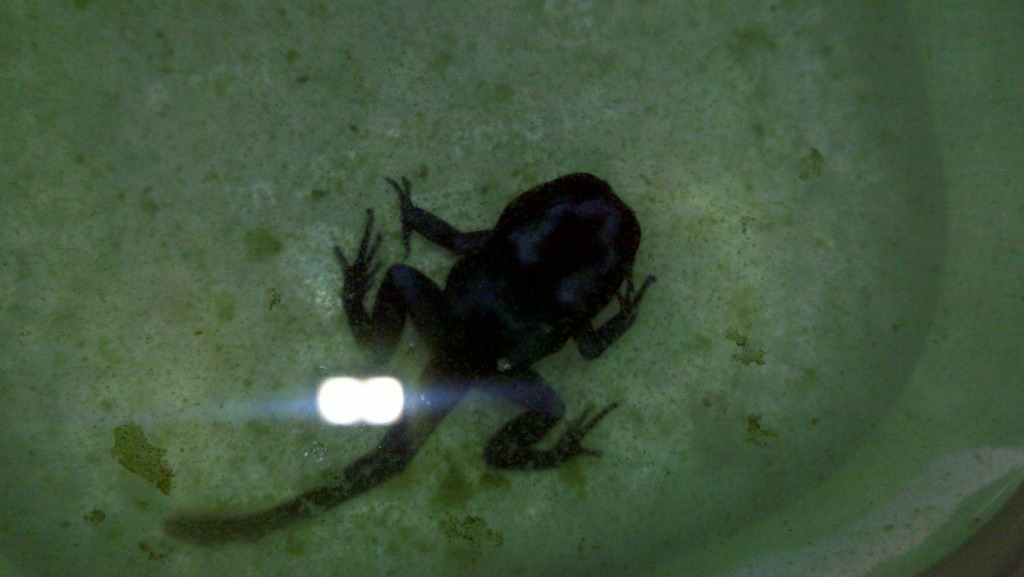
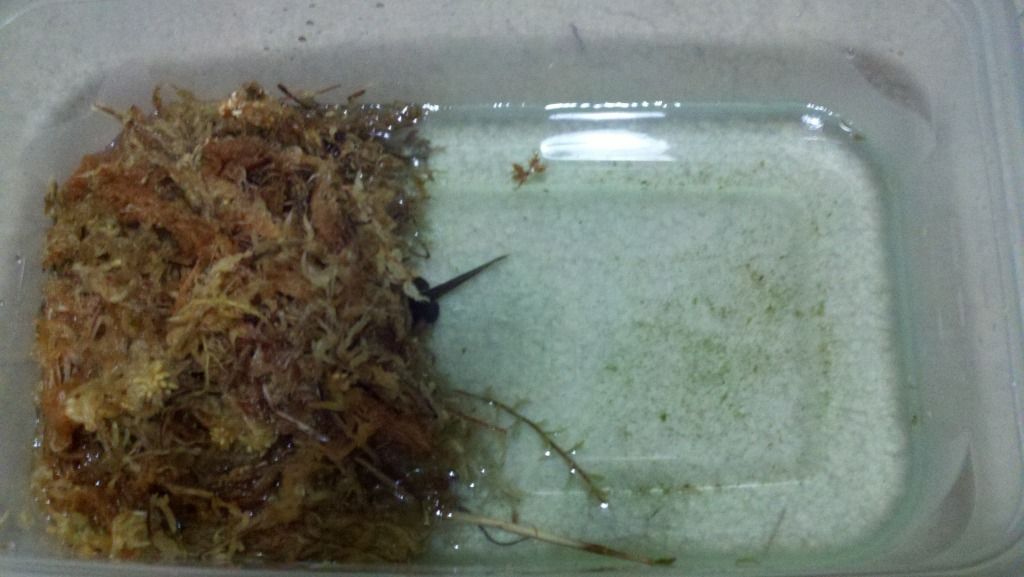
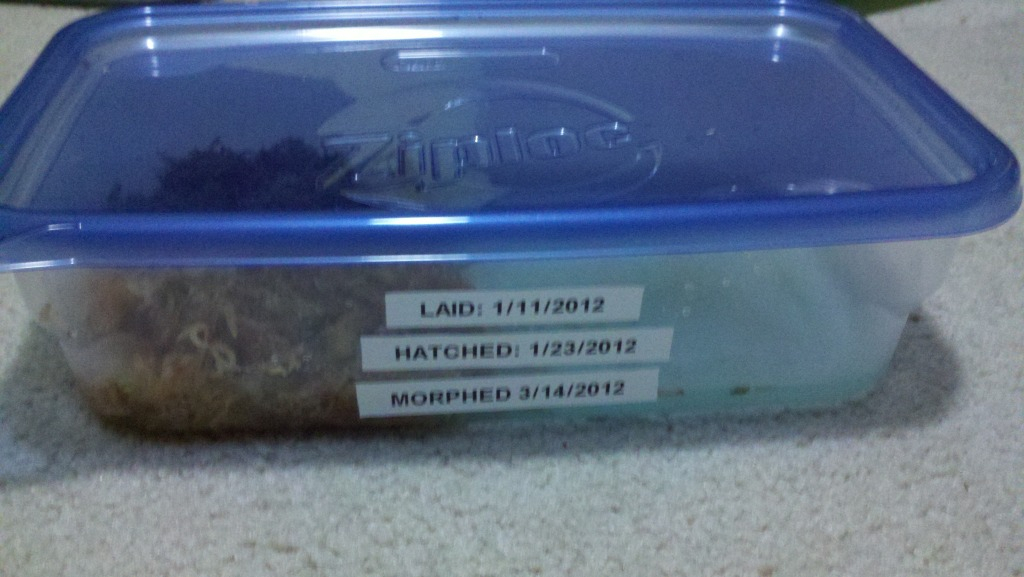
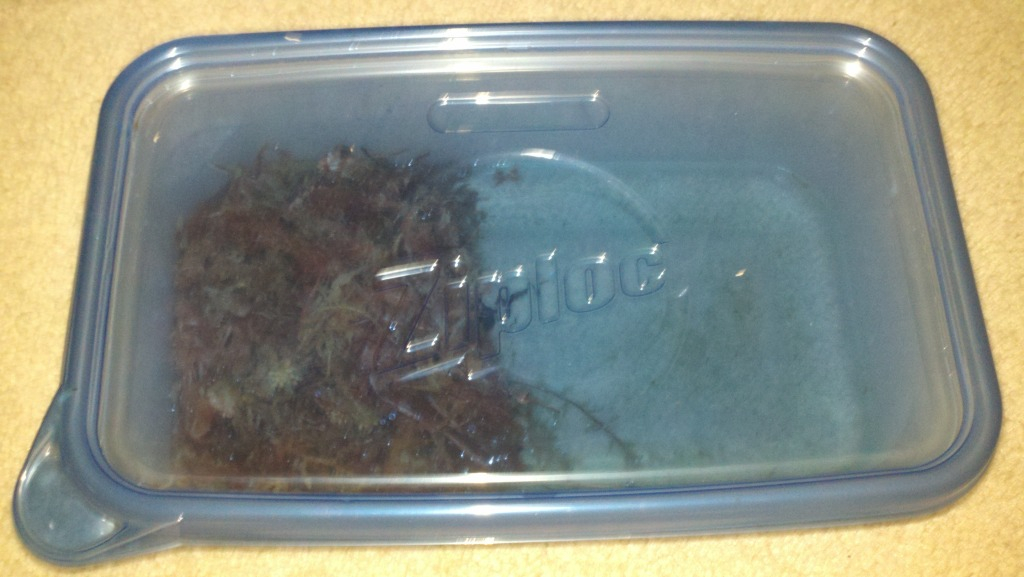
10. At this point, you just have to wait, about a week for the froglet to absorb its tail and crawl out of the water onto the moss. DO NOT FEED DURING THIS TIME. The mouth part is changing from the fish-like suction cup organ they ate the algae with to a mouth capable of eating flies. They couldn't eat during this change if they wanted to and soiling the water with food does more harm than good. When the froglet has completely absorbed its tail and has climbed out of the water onto the moss, suck the rest of the water out with the turkey baster so the new froglet doesn't accidentally drown.

11. Congratulations, you have successfully morphed out your first frogs! Now just feed them dusted wingless melanogaster fruit flies every day to every 2 days. Keep the cage wiped clean and spray with spring water before feeding. Be careful not to let the frogs jump out when you feed and clean. They can be feisty LOL.
12. After they are eating well and it has been about 1 or 2 months since they morphed out, they are ready to sell or move to a vivarium. This species does well in groups, so more than 1 is recommended per tank.
I think that is all. Let me know if I missed anything or if you have any questions.
Thanks,
Michael
This guide is not about adult dart frog husbandry, but I will go ahead and say a few things about that because you obviously have to have at least 1 healthy, happy pair of adults before you can get eggs.
I keep my quartet of adults in a 20 gallon long tank with hydroton and gravel on the bottom and sphagnum moss as the top substrate. Live plants are absolutely necessary for dart frog tanks. There are many that will work, but I like pothos because even I can't kill the stuff. The general rule is 1 frog for every 5 gallons of tank for this species, but bigger is always better and I wouldn't use anything smaller than a 10 gallon for a single frog or a pair, personally. For every frog in the tank, I have 1 coconut hide. Under each coconut hide is a cut-off deli cup so that the coconut hide sits inside the cup or around it. These deli cups are important for the breeding process. Feed the frogs every day or every 2 days on fruit flies that are dusted with RepCal and Herptivite. When your frogs are of breeding age, you should eventually see something like this in one of the deli cups:

1. When you have found eggs, take out the whole deli cup and replace it with a fresh one. Clean around the eggs and get rid of any debris that is in the cup with them. Be careful not to touch the gel around the eggs. If the eggs are dark and have no white "clouds" in them, they are good. If you have bad eggs that are cloudy white, they need to be removed with a q-tip so they don't cause others to go bad. Be careful not to disturb the other eggs much as you remove the bad ones.
2. When you have a mostly clean cup of eggs, get a tupperware, gladware, etc. container that is big enough for the cup of eggs to fit in. Fill the gladware container with an inch or 2 of water and float the deli cup inside the gladware container. This is your "incubator". Put just enough water in the actual deli cup so that the edge of the water touches the gel. Put the lid on loosely and store somewhere as close to 75 degrees as possible. You're done for a few days.


3. In a few days, you will see something like this, if the eggs are good:

Then another few days:

And after about 2 weeks, when the tadpoles start straightening their tails, add more water to help them out of the eggs:

4. When the tadpoles have hatched, you need to take them, one at a time, and put them in separate containers. I use 1 and 1/2 cup gladware or ziploc containers with lids. To remove the single tadpoles, I use an Asian soup spoon, but you can also use a turkey baster to suck up the tadpoles and put them in their new containers. Whichever method you use, be as gentle as possible. Put the lid on very loosely so that a little air can still get in, but flies can't.



5. When you have put the tadpoles into their new temporary homes, put a very small amount of food in with them. The best food I've found is the algae powder that Patrick Nabors sells at www.saurian.net. I also use BHB Frog/Salamander/Newt pellets every other feeding for extra protein. Feed every other day.
6. Every other day, before feeding, I use the turkey baster to suck out the poop and uneaten food from the last feeding, then refill the water. Only use spring water for amphibians. Never use tap water!
7. After a couple of weeks of feeding and cleaning, you should see back legs forming:

8. Soon after the back legs are fully formed, little bumps will start to form where the front legs will go.

9. When the front legs come in, it is time to move the froglet to another new home and stop feeding it for a while. I use long, ziploc or Gladware containers. Put a clump of sphagnum moss in one side of the container and fill it with enough water to soak the moss and still have about an inch of standing water. Suck most of the water out of the container the froglet is currently in, and gently poor the froglet into the new habitat.




10. At this point, you just have to wait, about a week for the froglet to absorb its tail and crawl out of the water onto the moss. DO NOT FEED DURING THIS TIME. The mouth part is changing from the fish-like suction cup organ they ate the algae with to a mouth capable of eating flies. They couldn't eat during this change if they wanted to and soiling the water with food does more harm than good. When the froglet has completely absorbed its tail and has climbed out of the water onto the moss, suck the rest of the water out with the turkey baster so the new froglet doesn't accidentally drown.

11. Congratulations, you have successfully morphed out your first frogs! Now just feed them dusted wingless melanogaster fruit flies every day to every 2 days. Keep the cage wiped clean and spray with spring water before feeding. Be careful not to let the frogs jump out when you feed and clean. They can be feisty LOL.
12. After they are eating well and it has been about 1 or 2 months since they morphed out, they are ready to sell or move to a vivarium. This species does well in groups, so more than 1 is recommended per tank.
I think that is all. Let me know if I missed anything or if you have any questions.
Thanks,
Michael
 Re: How to Breed Dart Frogs (Specifically D. auratus)
Re: How to Breed Dart Frogs (Specifically D. auratus)
Fantastic post Michael !
Snakeman- Rank: Black Mamba

- Posts : 1954
Join date : 2010-05-20
Age : 79
Location : Midwest City, OK.
 Re: How to Breed Dart Frogs (Specifically D. auratus)
Re: How to Breed Dart Frogs (Specifically D. auratus)
I agree (gulp!  ) with Larry. What a great tutorial and detailed pics. AWESOME Michael. Thanks! Tandy
) with Larry. What a great tutorial and detailed pics. AWESOME Michael. Thanks! Tandy

tandy- Rank: Black Mamba

- Posts : 666
Join date : 2010-05-21
 Re: How to Breed Dart Frogs (Specifically D. auratus)
Re: How to Breed Dart Frogs (Specifically D. auratus)
Great stuff here Michael!
Thanks for sharing and love the pic story line!

Thanks for sharing and love the pic story line!
RichardA- Rank: Bull Snake

- Posts : 40
Join date : 2013-06-11
OCHS Member Forum :: Amphibians :: Frogs
Page 1 of 1
Permissions in this forum:
You cannot reply to topics in this forum
